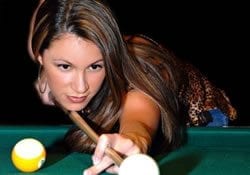 Play the Player, NOT the Table
Play the Player, NOT the Table
How many times has someone given you the advice to not worry about who your opponent is and just play the table? This statement is true if you’re talking about the mental game. Of course you don’t want to be intimidated by a strong player, or not try as hard against a weaker player. However, with regards to your actual PLAY (shot decisions, breaking strategies, and rhythm at the table) my advice is completely the opposite.
In matches with top level pros, it’s often a battle of break and runs so many times they’re only playing against themselves. However, most of us aren’t top level pros, and 99% of the time, we aren’t going to break and run. This means we actually have to play against the other person. In other sports, coaches and staff are paid millions and spend hours each week studying film, doing scouting reports and developing strategies for their upcoming games. So why should your strategy in pool be any different? Every player has strengths and weaknesses and both of those will come into play in most matches.
Identifying Your Strengths and Weaknesses
Many times you won’t know your opponent, so you probably won’t know their game very well either. Before you can think about exploiting your opponent’s weaknesses, you have to understand your own game. This is sometimes tricky because most players don’t analyze their game very well. This could be because you’re just not paying that much attention to the mistake you made when you lost, or it could be because you’re not being honest with yourself about why you lost a particular game.
In my first year playing pool, my instructor suggested I read an article by Tom Simpson called “100 Misses” (http://www.poolclinics.com/pdf/TS13.PDF). This is a great tool to assess what your weaknesses are, as long as you can be completely critical about your own game. This article tells you to record information about your next 100 misses. This could be a missed shot, a missed safety, missed shape for your next shot or even failing to make something off your break. It’s important to record the type of shot you missed as well as the reason why you missed it. The “why you missed it” part is the key to understanding your weaknesses. Sometimes you’ll lose because you run the table and miss a tough shot towards the end of the rack. But did you lose because you missed a tough shot that you need to practice, or did you lose because you played bad shape to get to that ball in your run? Maybe that particular pattern to play shape on that ball is what you have trouble with, rather than the hard shot you missed. So be critical of why you missed or lost a game. After 100 records, you’ll see patterns of what usually goes wrong in your game.
Many players don’t like to focus on their weaknesses, and as a result, don’t like to practice those shots. But, why would you only practice the things you already do well? So once you identify your weaknesses, take some time to work on getting better at those types of shots.
Strengths are usually a little easier to identify, but aren’t necessarily as overt as your weaknesses. Weaknesses can be specific shots, while strengths are usually overall concepts. For instance, some play their best when they are in a good rhythm; others are intimidating because they are aggressive players. My strength is my knowledge of safeties and kicking systems. When I win against a player that is higher ranked than me, it is usually because I won the close safety battles, not because I was able to run out more than them.
My First WPBA Win
In my first WPBA event of 2009, my first round match was a blur. I played Ga Young Kim, and although I won the first two games, ultimately I was no match for her. After that loss, I had to play a girl from my area. She had been our tour champion and a WPBA exempt player for several years and I’d never managed to beat her before. She’s a steady player, much slower than Ga Young Kim, but equally as capable of running out. Going into the match I decided that trying to out-run her was not going to work. I needed to stick more to my strengths. In doing so, I played many safeties after the break and focused on controlling the table and only taking high percentage offensive shots. The safety plays seemed to get her off of her rhythm when she would get an open table and she was not able to complete her run-outs as often as usual. Or, I would successfully get ball-in-hand after safeties and was able to get a comfortable lead in the match. In the end, I won the match 9-5 and finally beat a player that I was unable to beat in the past. In the past, I always fell into her style of play and tried to be better than her at HER game. That almost never works. So stick to your strengths, have confidence in what you know you do best, and continually analyze your own game.
Being constructively critical of your game and abilities (which change all the time) will help you develop at a faster rate and help you win against players who are arguably stronger than you. Next time you find yourself down in a match, think about the games that already took place, analyze what you’re doing well and what went wrong thus far in the match and decide how you can fix it before that match is over. Think about changing your game plan and you just might come out ahead.
Visit cristinadlg.blogspot.com to follow my tournament travels and email me with questions at crisdlg2005@yahoo.com.
